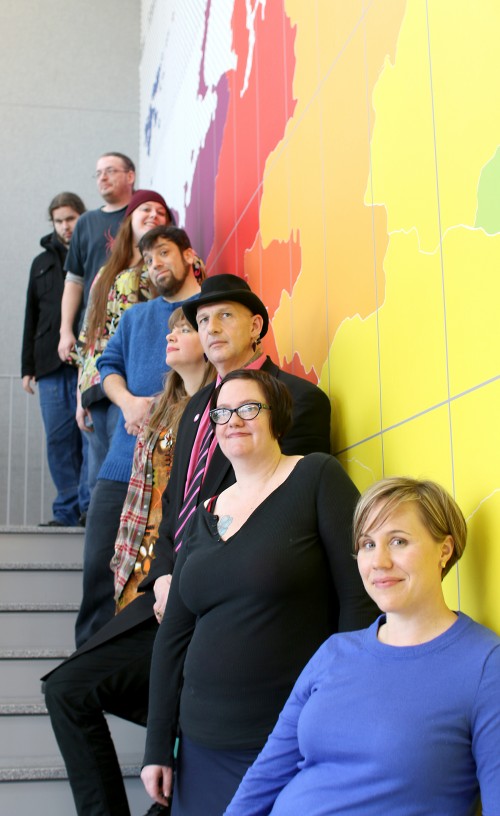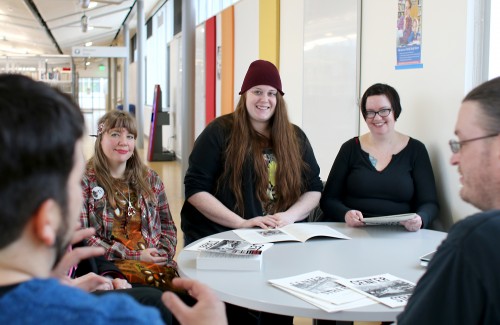This content was published: February 23, 2015. Phone numbers, email addresses, and other information may have changed.
Faculty, students forge creative union at Southeast Campus
Photos and story by James Hill
At the Southeast Campus, aspiring writers have more space to sit and put pen to paper.
Creative writers, thanks to the recent expansion of the campus, have a lot more classroom and study space to utilize as it expands the number of classes offered. English Department Chair Jessica Johnson said they have moved toward offering the full range of creative writing courses (poetry, fiction, nonfiction, and scriptwriting) at Southeast. This spring, her department will offer scriptwriting and the capstone of the creative writing sequence, Advanced Creative Writing, Editing, and Publishing, for the first time this spring. Since 2009, the program went from offering 2-3 classes in creative writing, poetry and fiction to seven courses each year.

The Writing Program, thanks to the recent expansion of the campus, has a lot more classroom and study space to utilize as it expands the number of classes offered. Here, students in the program along with Jessica Johnson (far right) and Blake Hausman (fourth from left) hang out in the new Library.
“We want to see just how big we can grow this community here at Southeast,” said Johnson, an accomplished author who recently wrote ‘Absolutes We Seek Each Other,’ a book of poems published by New Michigan Press and winner of the DIAGRAM Chapbook Contest. “These kinds of communities exist at the other campuses, but it’s a new thing for us. We just didn’t have the room before.”
The Creative Writing Club, which has approximately 50 members, is one facet of the program that’s benefited from the expansion. Started in 2012, the club hosts combined student/faculty readings and produces the literary journal “Center Street,” which features poems, short prose pieces, photos and art of the Southeast Campus community. In 2013, the club collaborated with another student club, Q Spot, to publish stories in celebration of National Coming Out Day, which won the writing club a district club award.
“I think this kind of student involvement at Southeast is a growing thing and will help keep students really engaged in the campus,” Johnson added.
Like Johnson, instructor Blake Hausman knows all about writing and publishing. His fiction has been published in Fiction International and the Yellow Medicine Review journals and his novel, ‘Riding the Trail of Tears’, is part of the University of Nebraska Press’s Native Storiers Series. He teaches the Native American and Science Fiction literature courses, and will offer Asian-American literature this spring. In addition, he organizes the writing club workshops and events, which feature students reading their work aloud in front of an audience.
“I think you have to perform your work and think about how it fills up dimensions and potentially how it affects people when you perform it,” Hausman said. “In addition to the publications, I think the writing club been so great in terms of creating that sort of venue. It’s been a real pleasure to be a part of this.
“There’s a lot of talent in Southeast Portland and the Southeast Campus feels like a magnifying glass for the creative energy in the general area,” he added. “As an artist, it’s a privilege to be able to work such a diverse and intense range of talent, because it inspires me to continue writing and being inventive.”
Often times students and faculty read out loud their work to one another in the club activities. Johnson said it breaks down the barriers between student and teacher. The instructors benefit because they are working on their own projects and can experiment with the readings. For students, they can learn from how the instructor performs and shows them how to take ownership of their work.
“It has been really fun,” said Johnson. “The creative writing faculty are usually working writers and it’s fun to interact on that level outside of class where the students and the instructors are vulnerable together. It’s a chance to be all together as working artists.”
What Students Are Saying About Southeast’s Writing Program:
Adam Hitt
Hitt, who is 12 credits away from graduating, is an older student, who returned to college after a 20-year hiatus from college. He is specializing in history and is taking creative writing classes to accent his learning.
“After my first creative writing class I completed a book and haven’t begun the process of revision yet which is why I’ve stayed on here,” Hitt said. “I like to take some more creative writing workshops. I enjoy it. The expansion here is great.”

The Creative Writing Club, which has more than 50 members, is one facet of the program that’s benefited from the expansion. Started in 2012, the club hosts combined student/faculty readings and produces the literary journal “Center Street,” which features poems, short prose pieces, photos and art of the Southeast Campus community.
Charles Claringbold
Claringbold is in his first year at PCC’s Southeast Campus. He graduated from high school in 1984 and started college in 2014. “I’m here for the jazz and the poetry,” he said. “I took poetry class from John Morrison last term with and it changed my life. I want to write stories and poetry, and continue on with that if I can at a four-year program.”
Christine Claringbold
A 1991 high school graduate, Claringbold is an artist by trade and takes classes with her husband Charles. They have hosted the creative writing class in the basement of their house where their band plays. Using the PA system, students get a chance to perform their poetry.
“I’ve always wanted to be a writer,” she said. “I was a writer back in high school and was on the school’s newspaper staff. I did all the writing festivals and kept a journal where I wrote poetry. But I had put it off for 20 years and now I’m back at it.”
Jami Collar
Collar, in her fourth year at PCC, returned to college after years in the grocery management business. Active in Phi Theta Kappa, student government and the Illumination Project, she said that the creative writing classes and the club have helped her realize her passion.
“This is the stuff that is the heart for me,” Collar said. “Writing has been the thing I’ve kept on the side burner my whole life. So finding community here really opened that up for me. Being able to stand up in front of people and do the readings here has been really powerful.”
Shawna Shadden
Biology major Shadden plans to transfer to Portland State University and study elementary education. Johnson’s creative writing class helped her overcome the fear of having other’s read her work.
“I loved it so much,” she said. “It was such a great experience for me. It was a safe space to read others work and have them read mine. It was a really good experience for me. So much so that I want to add more writing classes. This is my new favorite campus.”


This is exciting work!! Great work, Blake, Jessica, and all the students!!
I appreciate the spotlight on Creative Writing, but it seems unfortunate that the access described in the article is very SE-specific. I would have liked to see an article that showed how each campus represented its writers. I attend Cascadia because of accessibility reasons. I wish there was more writing and literature options offered each term. The Cascadia campus has a lot of potential as a community center for our writers, but it seems like students are not involved past the realm of the classroom.
Thanks for reading Julia. The article is about SE Campus’ growth in writing courses. That’s because it has just become a full campus, was able to offer more writing resources to students and we wanted to highlight this great development.
It’s a great development.